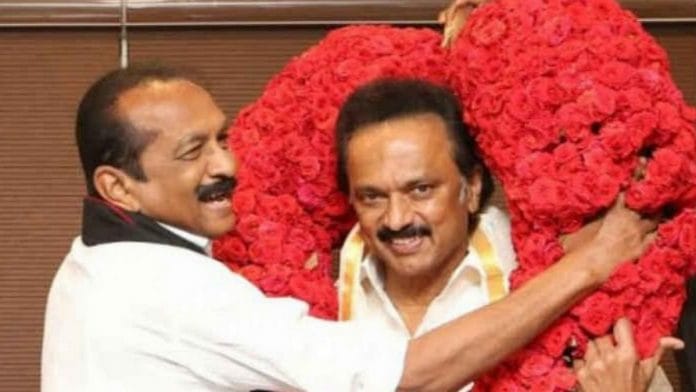Chennai: No one was very surprised when 89-year-old S. Duraisamy, a stalwart of Dravidian politics, quit the Marumalarchi Dravida Munnetra Kazhagam (MDMK) this Tuesday, accusing party chief V. Gopalsamy, better known as Vaiko, of “dynasty politics”. He had said as much in a bombastic and widely circulated letter in April, too.
However, more importantly, Duraisamy, presidium chairman of the MDMK until his resignation, has also suggested more than once that Vaiko should merge the party with the state’s ruling Dravida Munnetra Khazhagam (DMK) since there was no longer much difference between them.
In his resignation letter, too, he reportedly said it was best to merge the MDMK with its “mother party”, the DMK, for the sake of cadres.
Vaiko founded MDMK in 1994, shortly after he was ousted from the DMK over ideological differences as well as his vocal criticism of “dynasty politics” in the party, where it was becoming clear that patriarch M. Karunanidhi’s son M.K Stalin would be next in line to lead the party.
Stalin is currently the Chief Minister of Tamil Nadu and the MDMK is a part of the ruling DMK-led alliance.
Speaking to ThePrint, Duraisamy said that the MDMK’s best chance of staying relevant is if it merges with the DMK.
“MDMK was formed against the backdrop of dynasty politics in the DMK. Vaiko had alleged that Karunanidhi was paving the way for Stalin by sidelining others. But now, Vaiko is just repeating the same for the entry of his son (MDMK general secretary) Durai Vaiko,” Duraisamy alleged.
He added: “There is no requirement of a separate party — the MDMK — now. Rather, they can merge with the DMK for the greater good of the cadres and to fight communal political parties”.
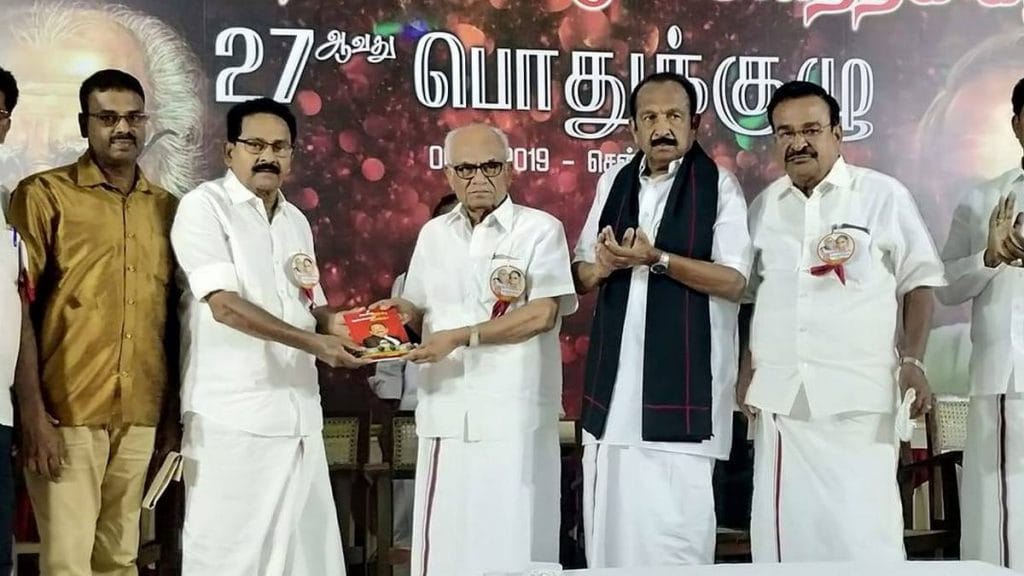
Vaiko in a press meet Tuesday dismissed all of Duraisamy’s claims and described his call for a merger as “strange”. He also claimed that his son’s ascent in the party was a result of the latter’s popularity with cadres.
“They (Party cadres) wanted him to be included in the party and I suggested a secret ballot; 104 out of the 106 office-bearers voted in his favour,” Vaiko said.
ThePrint reached Vaiko several times over phone for a comment, but received no response till the time of publication of this report.
Meanwhile, Duraisamy’s demand for a merger of MDMK and DMK has got Tamil Nadu’s political observers thinking. If such a merger did ever come to pass, it would be akin to a ghar wapsi, or homecoming, for the MDMK, said political analysts ThePrint spoke to.
The DMK, founded by C.N Annadurai in 1949, has served as the bedrock of Dravidian politics in Tamil Nadu. However, the party has witnessed many splinter groups — including the All India Anna Dravida Munnetra Kazhagam (AIADMK) and MDMK — emerging from its fold over the decades, usually spearheaded by sidelined or expelled leaders.
While some carved out their own niche, others faded into the background, if not oblivion.
Duraisamy, significantly, is the last surviving politician from the time of the original undivided DMK.
Fractured beginnings
The roots of the DMK go back to the Justice Party, which was formed in 1916 as a grouping of non-Brahmin leaders from Tamil Nadu. These leaders shared a common agenda of promoting social justice, rights for non-Brahmin groups, and Tamil language and culture.
In the 1930s, social reformer Periyar E. V. Ramasamy became the leader of this party and took a bright young political aspirant under his wing — C.N. Annadurai. The outfit changed its name to Dravidar Kazhagam in 1944, and propounded rationalism, ‘self-respect’, and Dravidian ideals that continue to shape Tamil Nadu politics today.
However, Annadurai and Ramaswamy fell out a few years later.
A.S. Panneerselvan, a fellow at Chennai’s Roja Muthiah Research Library, traced the growing tension within the movement to 1947 when a difference of opinion emerged between Annadurai and Periyar on the role of their organisation in newly-independent India.
“One of the differences was, are you going to be part of a state structure or are you going to be outside the electoral system. There was a set of people led by Annadurai who felt that they needed to be part of the state system to make changes. Electoral participation was a reason for the split,” said Panneerselvan.
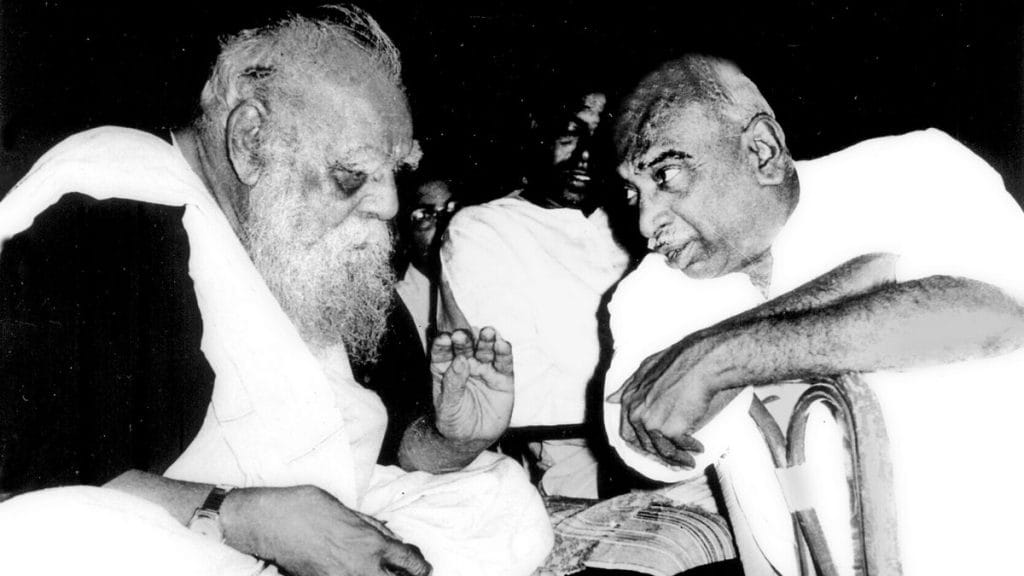
In 1949, Annadurai and his supporters formed a separate party called the Dravida Munnetra Kazhagam (which translates to Dravidian Progressive Federation), or DMK.
The party had a slow and bumpy start. In its first electoral fight in the assembly polls of 1957, it won only 15 seats. Four years later, it experienced its first split when Periyar’s nephew E.V.K. Sampath formed the Tamil National Party, which later merged with the Congress.
However, the DMK gained momentum in the 1962 election, securing 50 seats and becoming the opposition party in the state.
Finally, 18 years after its formation, the DMK got its big breakthrough in 1967, when it became the first non-Congress party to form a government in Tamil Nadu with a clear majority.
This marked the decisive beginning of Dravidian politics in the state, effectively marginalising national parties like the Congress and Bharatiya Janata Party in Tamil Nadu.
Following the demise of Annadurai in 1969, M. Karunanidhi took over the DMK leadership, surpassing V.N. Nedunchezhiyan, a senior member of the party, who had briefly served as acting CM.
Karunanidhi subsequently became the party head and Chief Minister, with the support of the majority of party members.
Big bang AIADMK, damp squib Makkal DMK
In 1972, film star-turned politician M.G. Ramachandran (MGR) was expelled from the DMK, reportedly following to a clash between him and Karunanidhi.
Shortly thereafter, MGR, who enjoyed a mass support base, floated a party named after Annadurai: the Anna DMK (later known as the AIADMK). In 1977, the party swept the assembly polls, with MGR ascending to the post of Chief Minister.
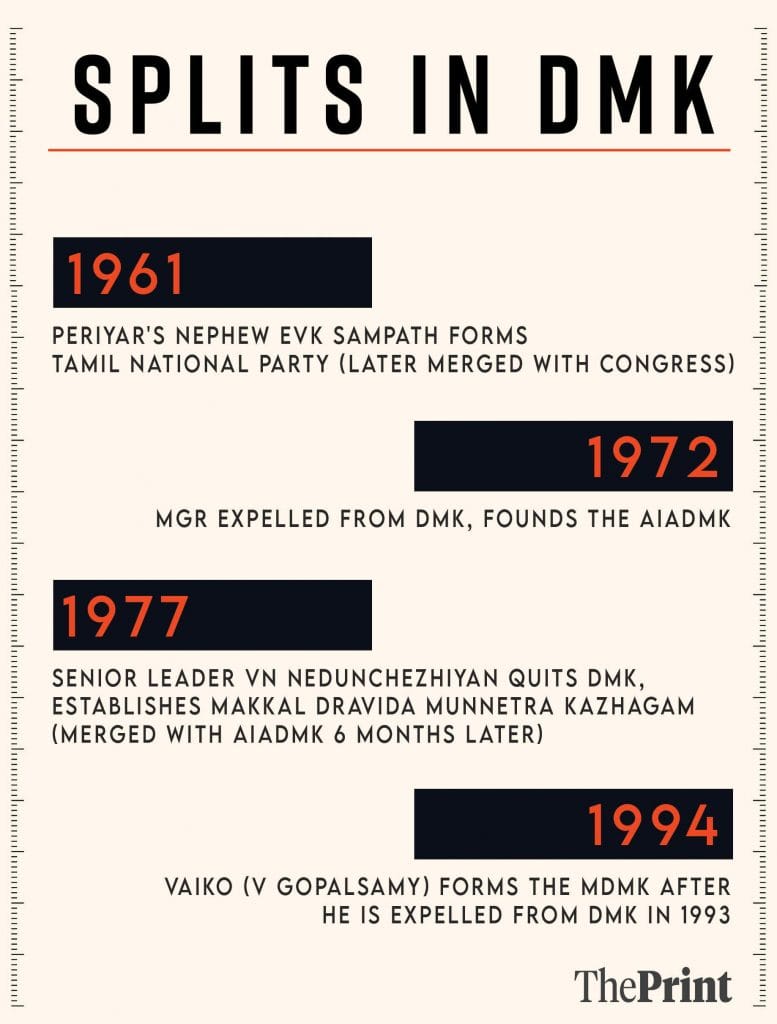
Around the same time, senior DMK leader Nedunchezhiyan also quit the party and formed the Makkal Dravida Munnetra Kazhagam, which soon merged with AIADMK.
“The reason for the split was very simple,” said analyst Panneerselvan. “The DMK had lost power in 1977 and AIADMK came to power, Nedunchezhiyan and three other senior cabinet colleagues of Karunanidhi after losing power floated the party and after six months eventually merged with AIADMK.”
AIADMK divisions, and a caste-based split
After coming to power in 1977, MGR stayed put in the CM’s chair (save for a brief spell of President’s rule in 1980) until his death in 1987.
There were a few internal conflicts and splits in the AIADMK during MGR’s reign. For instance, Nanjil K. Manoharan, a senior leader who was instrumental in the AIADMK’s growth, returned to the DMK in 1980, and expelled leader S.D. Somasundaram started a party called Namathu Kazhagum in 1984.
However, a full-fledged factional war broke out only after MGR’s death, between his wife Janaki Ramachandran and his protégé J. Jayalalithaa.
Ultimately, Jayalalithaa prevailed after the 1989 assembly election and helmed the party as its undisputed leader until her death in 2016, despite a few attempts at rebellion.
For instance, Neduncheyian, who formed a rival faction just ahead of the 1989 elections, returned to the AIADMK later. In 1996, S. Thirunavukkarassu formed the MGR Anna Dravida Munnetra Kazhagam after a rift with Jayalalithaa. The party contested with BJP backing in the 2001 Legislative polls and eventually joined the Tamil Nadu Congress Committee.
None of these splinter parties, however, could become a political force during Jayalalithaa’s lifetime, analysts say. After her demise, though, things seem to have changed.
In 2018, after a spell of infighting within the AIADMK, ousted leader T.T.V Dhinakaran— nephew of Jayalalithaa aide Sasikala — formed the Amma Makkal Munnetra Kazhagam (AMMK).
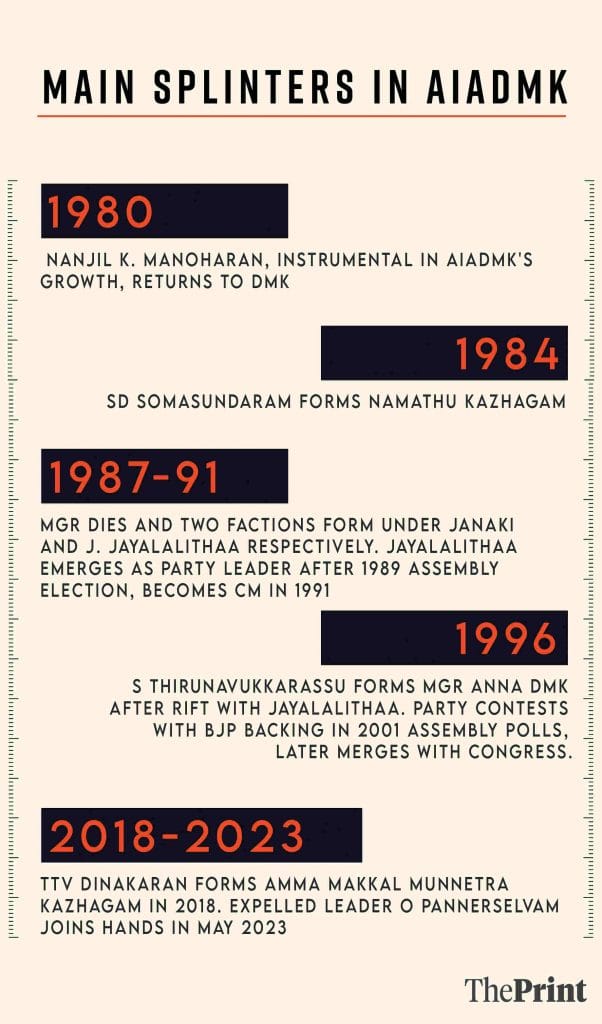
In May this year, ex-CM and expelled AIADMK leader O. Panneerselvam, or OPS, joined hands with one-time rival Dhinakaran to take on not just the DMK but “betrayers” in the AIADMK, which is currently led by Edappadi K Palaniswami, or EPS. Sasikala, OPS, and Dhinakaran all belong to the state’s influential Thevar community, while EPS enjoys a strong support base among the Gounder community.
The AMMK reportedly seeks to leverage the AIADMK’s Thevar vote-bank in its own favour.
According to analyst Panneerselvan, this caste-based turn is a departure from usual politics in Tamil Nadu.
“After Jayalalithaa’s death, the split is an interesting one. Before, the splits within the Dravidian parties were never casteist. This is the first time that caste affiliation is playing a major role in the party split,” he said.
Also Read: From MGR & Amma to EPS: How ‘Lion of Salem’ Palaniswami made AIADMK crown his own
Birth and fading of MDMK
There was a time when Vaiko, now 79 years old and a Rajya Sabha MP, was one of the most prominent leaders in the DMK, arguably second only to Karunanidhi. He joined the party in the 1960s, was famed for his eloquent and fiery oratory, and was a strong votary of Tamil nationalism.
However, a rift grew over time. In 1989, Vaiko reportedly undertook a clandestine journey to meet Velupillai Prabhakaran, the leader of Sri Lanka’s militant Liberation Tigers of Tamil Eelam (LTTE), which had been engaged in a face-off with the Indian Army.
“Vaiko’s Sri Lankan visit in 1989 without informing Karunanidhi was an embarrassing situation for the DMK,” political analyst Priyan Srinivasan told ThePrint.
This also ostensibly furthered the perception that Vaiko was getting a little too big for his boots and was trying to emerge as a challenger to Karunanidhi scion Stalin.
“Around the same time, a group supporting Vaiko had grown within the DMK and this was perceived as a threat to Stalin, who was being groomed to be the next in command,” Priyan explained.
The big turning point came in 1993, when Karunanidhi accused Vaiko of plotting with the LTTE to assassinate him and expelled the leader from the party.
In 1994, Vaiko formed the MDMK, with several other leader — including two-time MLA S. Duraisamy — joining him.
However, Vaiko’s support base never quite translated into electoral heft.
For over two decades, since it was formed, the MDMK relied on partnerships. It forged an alliance with the AIADMK for the 2001 assembly election and 2009 Lok Sabha polls, with the DMK in the 2004 Lok Sabha election, and then with the BJP in the 2014 Lok Sabha election.
It even created a six-party front called the Makkal Nala Kootani to challenge the DMK and AIADMK in 2016.
Following the passing of Karunanidhi in 2018, the MDMK once again revived its ties with the DMK for the 2019 Lok Sabha elections and has ridden pillion with it ever since, albeit at the cost of its own identity.
Duraisamy pointed out that in that election [2019], as well as the 2021 assembly polls, MDMK candidates were compelled to contest under the rising sun symbol of the DMK.
In that election, DMK got 133 of 234 assembly seats, the AIADMK bagged 66, and the MDMK won four of the merely six seats it contested.
According to Duraisamy, the party is no longer bringing anything substantial to the fray.
“The reason why Vaiko is not merging with the DMK is because he thinks that he can benefit from being an individual party. If you want to fight communal parties, you can join the DMK and fight them. Why do you need an individual party?” he argued.
Some analysts agree. “The necessity for having a party like the MDMK has become outdated and obsolete,” said Priyan.
Dravidian bastion vs national parties
Ever since the DMK first came to power, Dravidian parties have formed the main pillar of Tamil Nadu’s electoral politics.
Analysts say all these parties purport to stand for five key principles, all based on the vision of Annadurai — social justice, women’s empowerment, casteless and equal society, Tamil Nadu’s state rights, and self-respect.
In the past five decades, Tamil Nadu has been primarily dominated by either the DMK or AIADMK, leaving national parties like Congress and BJP dependent on them for electoral success.
However, several other Dravidian parties have also emerged, some with notable achievements.
One such party is the Desiya Murpokku Dravida Kazhagam (DMDK), founded by actor Vijayakanth in 2005.
In the 2011 state assembly polls, in alliance with left parties and AIADMK, the DMDK won 29 of the 40 seats it contested, becoming the main opposition party, leaving even the DMK in third place.
However, DMDK’s subsequent attempts to form a third front with the MDMK in the 2014 polls did not yield much fruit, and the party’s performance in the following elections has been disappointing.
After the passing of Jayalalithaa and Karunanidhi, a political vacuum emerged in the state, leading actor Kamal Haasan to launch a party called Makkal Needhi Maiam (MNM) in 2017.
During its launch, Haasan hademphasised that his party was neither left nor right but centred on Dravidian ideology. However, in the 2021 assembly polls, MNM failed to secure any seats despite contesting from 183 constituencies, managing only a 2.62 per cent vote share.
Another popular actor, Rajinikanth, had expressed his intention to launch a party, but in December 2021, he announced that he wouldn’t proceed due to health issues.
In the meantime, the BJP, which is still piggy-backing on its ally AIADMK, has been persistently trying to make inroads in the state.
Analysts point out that there is high pressure on Dravidian parties to uphold the existing political ecosystem.
“Because of BJP’s attempt to make inroads into the state, the need for the presence of Dravidian parties in the state is much stronger. At present the Stalin-led DMK has a tough ideological battle with BJP. If Stalin lets go this time, then the political course of the state will change,” Priyan said.
He added that Stalin is facing what is perhaps the biggest test yet for the DMK: “With the weight of the party on his shoulders, Stalin is now confronting a greater challenge than Karunanidhi.”
(Edited by Asavari Singh)
Also Read: BJP, AIADMK demand TN minister Balaji’s removal as I-T dept raids 40 properties linked to him



